
 The newsletter of NASA's Radio JOVE Project
The newsletter of NASA's Radio JOVE Project"Solar and Planetary Radio Astronomy for Schools"

 The newsletter of NASA's Radio JOVE Project
The newsletter of NASA's Radio JOVE Project
Three electrical engineering students at Case Western Reserve University tested a commercial Software Defined Radio (SDR) unit against the Radio JOVE RJ1.1 receiver and calibrator to see if they could develop a simpler, less expensive option for the public. Their results were promising but they found more work needed to be done.
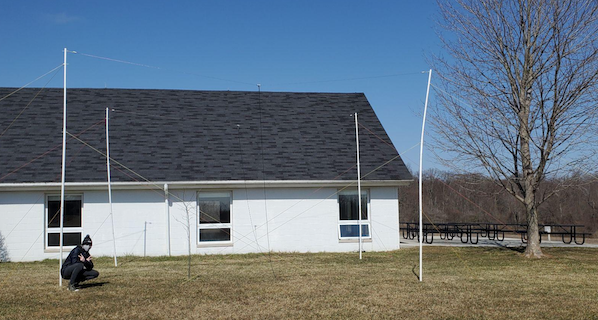
A SDR is a radio system that uses computer software in place of traditional electronic hardware. Many of these SDRs are quite small and often connect with a personal computer using the USB port. The students compared one model of SDR, the RTL-SDR, which is among the least expensive (~$25 USD) of many types of SDRs available.
The students, Skyler Dannhoff, Tyler Kovach and Jared May, began their investigation by finding a radio-quiet site on a farm to set up the standard dual-dipole antenna array. Next, with the RTL-SDR the students used GnuRadio software on an inexpensive Raspberry Pi computer to replicate the receiver functionality and collect the data. After testing that the antenna performed as expected they confirmed that the Radio JOVE receiver could detect the galactic background from the site by running the RJ1.1 receiver over several hours at night. Their SDR was then tested to confirm it could receive AM, FM and 20 MHz test signals with a different antenna. Finally, the students connected the SDR to the dual dipole antenna and tested the system for reception of the galactic background. The students confirmed that the RTL-SDR could receive and record data at 20.1 MHz. However, the RTL-SDR auto gain control (AGC) made comparison with the Radio JOVE system difficult and the students provided suggestions on how this AGC could be overcome. Due to the fluctuations in the noise level it wasn't clear that the galactic background was detected with the SDR. Their final report provides guidance on future investigations and modifications of the system.
The inexpensive 8 bit RTL-SDR dongles were designed as TV tuners to receive strong broadcast FM and television signals not weak signals necessary for detecting Jupiter storms. The lack of any easy way of defeating the internal AGC and automatic volume control (AVC) prevents detecting the galactic background hump. They are fun for solar and general experimentation. SDR receivers not specifically designed for scientific studies often exhibit these issues. Congratulations to the Case Western Reserve students for their extraordinary and complete research and documentation.
We've received exciting news from two schools that are creating new software applications that work with Radio JOVE receivers and new hardware to make the Radio JOVE receivers more accessible.
Andrew Abate from Riverdale Country School in the Bronx, New York, reports on a project led by three students from the school to create a web-based application to receive and record data from the Radio JOVE receiver. The application saves the data in both the Radio-SkyPipe spd file format as well as in JSON format. They are now working on a means to access the Radio JOVE archive through the same application.
Darsa Donelan, physics professor at Gustavus Adolphus College in Saint Peter Minnesota, reports on a project their team is working on to adapt the Radio JOVE receiver for a researcher with a degenerative neurological disorder. Among the adaptations to the design is to replace the tuning knob with a digital tuner. The team will also be adding new software as a means to automate the data acquisition remotely.
We are looking forward to hearing more reports from teams that are modifiying the Radio JOVE system. Let us know how it turns out!
In May 2021, Wes Greenman did it again - he retired - this time from Radio JOVE. Wes gave 40 years of service to the University of Florida in the Astronomy Department, and 25 years to Radio JOVE as one of the founders of the project in 1997. He also co-developed the dual-dipole radio antenna, and ordered and bagged the receiver parts for the kits. We estimate that Wes handled over a quarter-million parts! Happily, Wes will continue making his excellent observations with Radio JOVE from his observatory in Alachua, Florida. Below are some pictures from the dinner celebration, and a copy of the letter and plaque given to Wes.
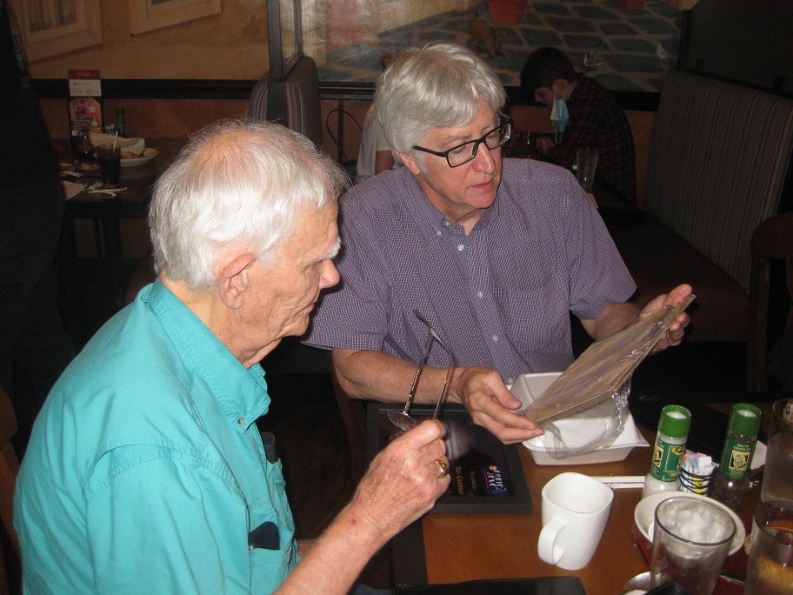
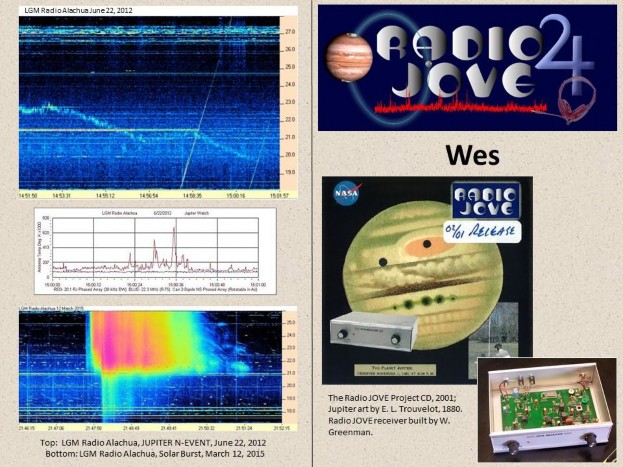
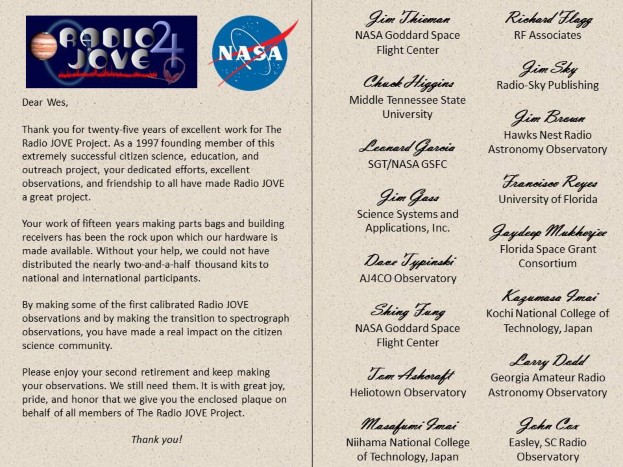
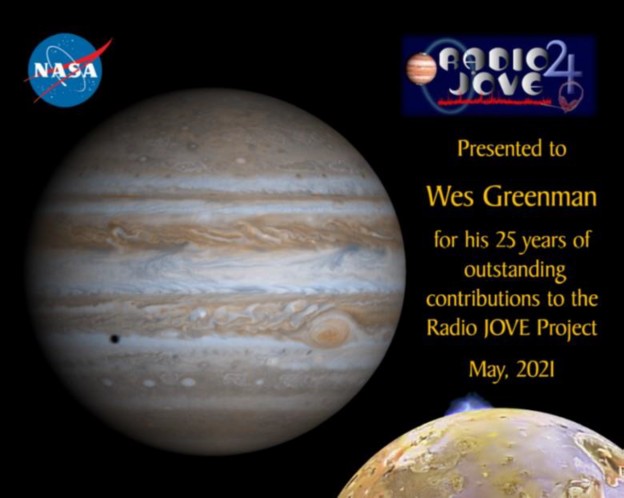
Have you thought about a Radio JOVE satellite in space? As we recently reported in a brief overview on the Radio JOVE 2-Unit CubeSat project [1], we are now happy to announce that this CubeSat called KOSEN-1 is ready to be launched from the Uchinoura Space Center in Japan on October 1st, 2021. As shown in Figure 1, KOSEN-1 is one of nine satellites in the Innovative Satellite Technology Demonstration-2 [2] carried by a JAXA Epsilon-5 Launch Vehicle (Figure 2). Figure 3 shows a computer generated graphic of how KOSEN-1 and ARICA (a 1-U CubeSat for monitoring transient events of gamma-ray bursts) are released in a Sun-synchronous Sub-recurrent Orbit. The full movie can be found on YouTube at (https://www.youtube.com/watch?v=pLghraclhXs).
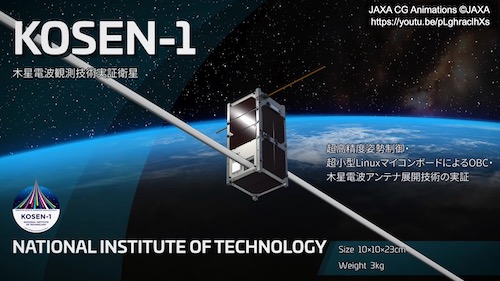
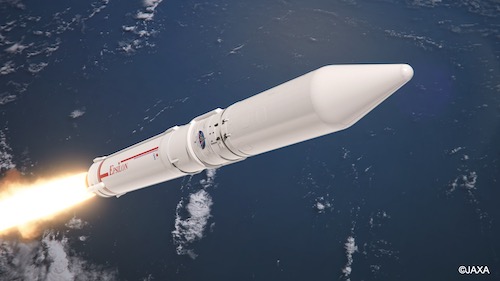
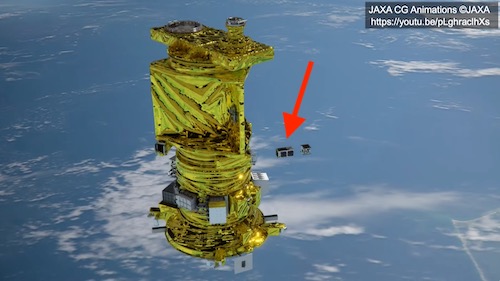
KOSEN-1 is the first 2-Unit CubeSat developed by 10 colleges of the National Institute of Technology (abbreviated as KOSEN in Japanese) in Japan. The CubeSat includes three key technologies to (1) demonstrate a high-accuracy attitude control system, (2) utilize an on-board computer with a Linux microcomputer board, and (3) deploy a 7-m long dipole antenna from the CubeSat for Jupiter radio observations. The scientific target is to capture Jovian millisecond short-bursts (S-bursts) in collaboration with ground-based radio telescopes to better understand Jupiter's decametric radio beaming structure [3]. KOSEN-1 has a software-defined radio (SDR) receiver that can monitor the electric fields of the waves around 20 MHz (similar to the frequency of the Radio JOVE receiver) by means of a 7-m long dipole antenna. The SDR receiver can provide both waveforms and spectra in a 2-MHz bandwidth depending upon the available telemetry to the ground, while the timing of the records is synchronized with the GPS 1 Pulse-Per-Second. Once it is launched, KOSEN-1 will maintain its polar orbit around Earth, freely observing Jovian decametric radiation. We propose to observe a total of 16 Io-related S-burst events with KOSEN-1 and ground-based radio telescopes, including LWA1 and LWA-Sevilleta. Details of the observing campaign are provided in Table 1. We welcome the Radio JOVE community to participate in the KOSEN-1 Jupiter radio observation campaign in 2021.
| Date YY-MM-DD | Time (UT) | Jupiter Storm | Jupiter
Elevation (degrees) from LWA1, New Mexico, USA |
|---|---|---|---|
| 21-10-07 | 03:10-04:25 | Io-A/C | 40-41-40 |
| 21-10-08 | 03:10-04:20 | Io-B/D | 40-41-40 |
| 21-10-14 | 02:45-03:55 | Io-A/C | 40-41-40 |
| 21-10-15 | 03:10-03:50 | Io-B/D | 41-40 |
| 21-11-02 | 01:25-02:00 | Io-B/D | 40-41 |
| 21-11-08 | 01:00-02:25 | Io-A/C | 40-41-40 |
| 21-11-09 | 00:55-02:25 | Io-B/D | 40-41-40 |
| 21-11-15 | 00:25-02:05 | Io-A/C | 40-41-40 |
| 21-11-16 | 00:25-02:05 | Io-B/D | 40-41-40 |
| 21-11-22 | 00:40-01:40 | Io-A/C | 41-42-40 |
| 21-11-23 | 01:25-01:40 | Io-B/D | 41-40 |
| 21-12-10 | 22:45-23:10 | Io-B/D | 40-42 |
| 21-12-16 | 22:20-23:35 | Io-A/C | 40-43 |
| 21-12-17 | 22:20-23:50 | Io-B/D | 40-43-42 |
| 21-12-23 | 21:50-24:20 | Io-A/C | 40-43-40 |
| 21-12-24 | 22:20-24:20 | Io-B/D | 42-43-40 |
References
Do you have used Radio JOVE RF-2080 C/F calibrators? There are Radio JOVE observers looking to buy them. As you know, RF-2080 C/F units are no longer available for purchase as new. However, we have some radio observers using the Radio JOVE RJ1.1 receiver that do not have a calibrator and are looking for one. The Calibrator/Filter is highly recommended to make observations more useful for science. The cost of these items as new was $100 USD.
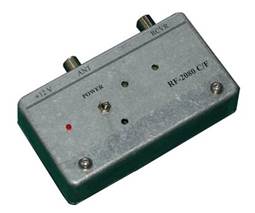
Please post and search for the RF-2080 calibrators on your favorite Online marketplace (eBay, Etsy, Alibaba, etc.). The RF-2080 C/F units are well built and are fairly rugged; thus, these units should be okay to buy and sell. All transactions are person-to-person, and Radio JOVE does not guarantee or is not liable for any defective equipment. We are simply encouraging the sale of used equipment to help other observers. These items require a 12 V power supply, and we recommend the Jameco ReliaPro 6 Watt AC-to-DC Regulated Linear Wall Adapter 12 Volt 0.5 Amp (Jameco Part no.: 162996, cost $12.95 USD). The reason for this recommendation is that many other power supplies give off radio frequency interference (RFI), and you do not want RFI around your radio telescope.
If you wish to donate your used RF-2080 calibrators, Radio JOVE will find a high school or college that will use it for a student project. Please contact Chuck Higgins at chiggins@mtsu.edu to arrange the donation. Thank you.
The JOVE Bulletin is published twice a year. It is a free service of the Radio JOVE Project. We hope you will find it of value. Back issues are available on the Radio JOVE Project Web site, http://radiojove.gsfc.nasa.gov/
For assistance or information send inquiries to:
or
